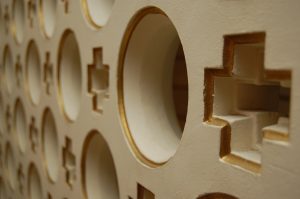1st period: the 1860s
1861. Cardinal Wiseman, Archbishop of Westminster, asked the Marist Fathers to establish a mission for the French community in London. Father Charles Faure was in charge of the project.
25 March 1865. Father Charles Faure bought a circular building off Leicester Square. It was called the ‘Burford’s Panorama’ an early form of visual entertainment in the West End. It was built as a tourist attraction in the latter part of the 18th century.
1865. The French architect, Louis Auguste Boileau, was one of the promoters of cast iron architecture. He transformed the rotunda into a church, hence the circular shape of the present building.
11 June 1868. Consecration of the new church which was the first one built using cast iron in London. The church’s mission included a hospital, an orphanage and two schools which were run by the Sisters of Saint Vincent de Paul (Daughters of Charity).
2nd period: bombing and reconstruction (1940-1955)
6 November 1940. During the battle of Britain, two bombs caused substantial damage to the church building, fortunately without loss of life.
23 November 1941. The church reopened after extensive repairs overseen by the Superior of the parish, Father Laurent.
September 1948. The full reconstruction of the church was authorised and managed by the new Superior, Father Deguerry. He had the support of the French Ambassador Jean Chauvel, the cultural attaché René Varin and the British Prime Minister, Anthony Eden.
31 May 1953. Maurice Schumann, French Foreign Secretary, laid the foundation stone of the new building, which was brought from the Cathedral of Chartres. The architect was Hector Corfiato of Beaux Arts de Paris.
6 October 1955. Cardinal Feltin, the Archbishop of Paris presided over the official consecration. The new building was still in need of decoration.
3rd period: decoration of the church (1953-1960)
Cultural Attaché René Varin encouraged the creation of a sacred space, which would honour France. He approached eminent artists of the time.
4th period: (1960-present days)
1960s More and more activities were developed to meet the growing demand of parishioners:
- Chaplaincy of the Lycée, Conference of St Vincent de Paul, Our Lady of Walsingham Centre.
- 1964 the Notre Dame de France Charitable Trust was established
1970s New initiatives:
- Centre Charles Péguy with its conferences, meetings, visits
- Christian Association of Mauritians in London which facilitated their integration into the life of the city
1980s
- Marist Fathers leave Notre Dame de France (1987)
- Parish is run by the Chaplaincy for the Overseas French Catholics (DGAFE)
- Chaplaincy to the French Lycée Charles de Gaulle expands
1992 Return of the Marist Fathers and new developments in parish life:
- Notre Dame Refugee Centre
- Service to the homeless
- Welcoming Room
- The Taizé Group
- Support for the Francophone African communities in London
- Pastoral activities with West End local churches
2000-today
- The four Catholic churches of the West End of London – Corpus Christi, Notre Dame de France, Our Lady of the Assumption and St Gregory, and St Patrick’s – developed a series of charitable and evangelizing initiatives
- The number of French-speakers in London grew considerably, with ever-growing calls on the pastoral services of Notre Dame de France
- The team of priests’ was expanded, the organizational and governing structures in the parish evolved
- Competent people were employed in coordinating the services
- The organization of Notre Dame de France was brought into full conformity with the legal norms governing charities
- Organisational development in all sectors of the parish – school chaplaincy, sacramental preparation, articulating the mission, involvement of teams of lay people, evangelization in the area




